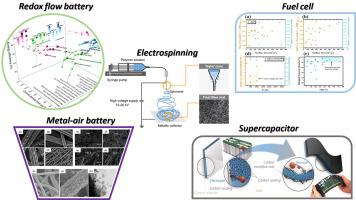Journal of Energy Chemistry ( IF 14.0 ) Pub Date : 2020-11-18 , DOI: 10.1016/j.jechem.2020.11.014 Yue Wen , Matt D.R. Kok , Jorge Pavel Victoria Tafoya , Ana B. Jorge Sobrido , Ellsworth Bell , Jeff T. Gostick , Servann Herou , Philipp Schlee , Maria-Magdalena Titirici , Dan J.L. Brett , Paul R. Shearing , Rhodri Jervis

|
Electrospinning has been proven as a highly versatile fabrication method for producing nano-structured fibres with controllable morphology, of both the fibres themselves and the void structure of the mats. Additionally, it is possible to use heteroatom doped polymers or to include catalytic precursors in the electrospinning solution to control the surface properties of the fibres. These factors make it an ideal method for the production of electrodes and flow media for a variety of electrochemical devices, enabling reduction in mass transport and activation overpotentials and therefore increasing efficiency. Moreover, the use of biomass as a polymer source has recently gained attention for the ability to embed sustainable principles in the materials of electrochemical devices, complementing their ability to allow an increase in the use of renewable electricity via their application. In this review, the historical and recent developments of electrospun materials for application in redox flow batteries, fuel cells, metal air batteries and supercapacitors are thoroughly reviewed, including an overview of the electrospinning process and a guide to best practice. Finally, we provide an outlook for the emerging use of this process in the field of electrochemical energy devices with the hope that the combination of tailored microstructure, surface functionality and computer modelling will herald a new era of bespoke functional materials that can significantly improve the performance of the devices in which they are used.
中文翻译:

静电纺丝作为选择低温电化学装置的先进碳纤维材料的途径:综述
电纺丝已被证明是一种高度通用的制造方法,用于生产具有可控形态的纤维本身和毡垫的空隙结构的纳米结构纤维。另外,可以使用杂原子掺杂的聚合物或在电纺丝溶液中包括催化前体以控制纤维的表面性质。这些因素使其成为用于各种电化学装置的电极和流动介质生产的理想方法,从而能够减少质量传递和活化超电势,从而提高效率。而且,最近,由于将生物可持续性原理嵌入电化学装置的材料中,使用生物质作为聚合物来源已引起关注,通过其应用来补充其允许增加可再生电力使用的能力。在这篇综述中,对用于氧化还原液流电池,燃料电池,金属空气电池和超级电容器的电纺材料的历史和最新发展进行了全面回顾,包括对电纺丝工艺的概述以及最佳实践指南。最后,我们展望了该工艺在电化学能源设备领域的新兴应用,并希望将量身定制的微观结构,表面功能和计算机建模相结合,将开创可以显着提高性能的定制功能材料的新时代。使用它们的设备的数量。全面回顾了用于氧化还原液流电池,燃料电池,金属空气电池和超级电容器的静电纺丝材料的历史和最新发展,包括静电纺丝工艺概述和最佳实践指南。最后,我们展望了该工艺在电化学能源设备领域的新兴应用,并希望将量身定制的微观结构,表面功能和计算机建模相结合,将开创可以显着提高性能的定制功能材料的新时代。使用它们的设备的数量。全面回顾了用于氧化还原液流电池,燃料电池,金属空气电池和超级电容器的静电纺丝材料的历史和最新发展,包括静电纺丝工艺概述和最佳实践指南。最后,我们展望了该工艺在电化学能源设备领域的新兴应用,并希望将量身定制的微观结构,表面功能和计算机建模相结合,将开创可以显着提高性能的定制功能材料的新时代。使用它们的设备的数量。











































 京公网安备 11010802027423号
京公网安备 11010802027423号